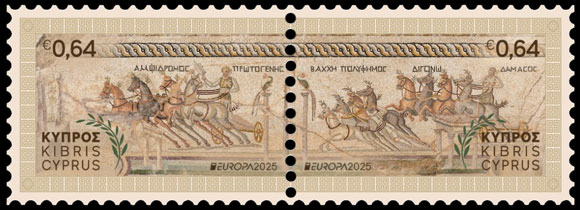
On May 9, 2025, the Hellenic Postal Administration of Cyprus issued a series of postage stamps titled "National Archaeological Discoveries" as part of the Europe 2025 project.
The theme for this two-stamp set is a stunning archaeological find: a large floor mosaic depicting chariot races at the ancient Roman hippodrome.
The mosaic floor depicting chariots was discovered during excavations conducted by the Cyprus Department of Antiquities near the village of Akaki in the Nicosia district. It is part of the floor decoration of a wealthy Roman country villa dating from the 4th-5th centuries CE.

The mosaic is remarkably well-preserved and impresses with its exceptional craftsmanship and attention to detail. It is the only ancient mosaic in Cyprus depicting such a theme. Despite the immense popularity of chariot racing in ancient Rome, only seven mosaics depicting this theme have been discovered worldwide to date. Individual depictions of chariots are quite common, but such a comprehensive work that depicts the hippodrome and chariot racing in detail is a rarity.

The 26-meter-long mosaic depicts a race between several chariots at the hippodrome. Each chariot is drawn by four horses, driven by a charioteer. We see several stages of the race, as if watching the chariots in action. Above each quadriga are Greek inscriptions, presumably the name of the charioteer and one of the horses. These inscriptions allow us to "recognize" the chariots at different stages of the race. In addition to the chariots, the mosaic also depicts the hippodrome itself in detail: the central barrier (Latin: spina), decorated with columns, obelisks, and dolphin sculptures in honor of Neptune, patron of equestrian competitions. We also see the "employees" of the hippodrome: a groom with a whip, a water carrier, and a rider.

Renowned designer Angeliki Athanasiadi masterfully tackled the challenging task of translating a monumental mosaic into a miniature postage stamp format while preserving its spirit and dynamism. The combination of two stamps with a continuous design allowed for a larger "canvas" and allowed for the dynamic opening of the chariot races to be captured.
Chariot races in ancient Rome were a spectacle of extraordinary power and passion. Quadriga races were extremely dangerous: collisions and breakdowns of chariots, and the deaths of drivers and horses were commonplace. Victory at the hippodrome was achieved in a tense struggle and promised not only money but also glory.
The Cypriot mosaic from Akaki is a reminder of strength, courage, and triumph that has endured through the ages. And the new Cyprus issue is more than just a stamp. This is a ticket to the past, to the stands of the ancient Roman hippodrome, where the air trembled with the shouts of spectators and the neighing of horses, and the lives and destinies of people depended on the outcome of the race.

Sources: cypruspost.post
Перейти в каталог
I apologize for any errors or inaccuracies


